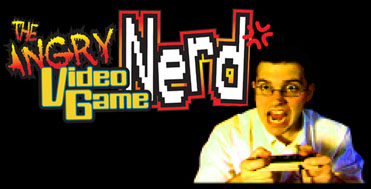The “Angry Video Game Nerd” (type in that phrase on YouTube or go to his website) uses modern production values (film clips and staged scenes to go along with the typical voice-over-game-footage) to capture the nostalgia of vintage games. There are a lot of video game reviewers on YouTube, but no one brings back those old cartridges like the AVGN (actually named James Rolfe).
This is despite the fact that he mostly reviews the bad games, consoles and accessories, not the good ones.
I used to think that when I didn’t like a game (such as, for example, “E.T. The Extra Terrestrial” for the Atari 2600, considered by many to be the worst game ever), it meant I didn’t like gaming. But the AVGN — who has a room filled wall-to-wall with games, console/TV hookups and gaming posters — hates so many games that I now realize it wasn’t me, it was the games.
The gaming industry has put out many subpar products through the years — that “E.T.” game, the Atari 5200 (more advanced than the 2600, but shoddily constructed), Sega’s 32X (which had to be plugged into the Genesis in an ungainly fashion) and Nintendo’s Power Glove (with such unreliable functionality that it was easier to go back to the basic controller) are a few classic examples that the Nerd has devoted episodes to.
“E.T.” is a horribly designed game that — one could argue — tried to do more than the Atari console was capable of; it tried to be an adventure game on a system that leant itself to simpler games. The best games of any console are those that didn’t push the boundaries: “Breakout,” “Space Invaders” and “Asteroids” for Atari; “Tetris,” “Dr. Mario” and arcade adaptations (I’m partial to “Teenage Mutant Ninja Turtles” II and III) for Nintendo; and side-scrolling adventures (I’m partial to the “Super Star Wars” series) for Super Nintendo.
But pushing the boundaries is what ultimately leads to better products. That gun that was supposed to work for “Duck Hunt” was terrible only because it didn’t work, not because there was something wrong with the concept. The Sega CD system was silly because many of the games were more like watching movies than playing a game, but it paved the way for games-with-video-clips such as “Star Wars Galaxies.” The Nintendo Power Pad was the precursor to “Dance Dance Revolution,” and the Power Glove set the stage for the Wii.
Gamers, like all entertainment consumers, are savvier today, so we see fewer duds reach the marketplace. But in the vintage gaming era (the AVGN focuses on Super Nintendo and prior, and that’s my wheelhouse, too), a lot of duds were released. These epic failures have not become more playable with time, but in a way they have become more lovable, if only because they are cultural touchstones.
I’ll use the first “Teenage Mutant Ninja Turtles” game for the Nintendo as an example because it’s the only game the AVGN has reviewed that I played. Being a casual gamer, I gravitated toward the safe, good games (the “Super Mario” series and those puzzle games), but this one snuck through the cracks because I was a serious “TMNT” fan in the early 1990s.

It’s a ridiculously challenging game, but not challenging in the way it’s supposed to be. You know what I mean: It’s challenging because of design flaws, like a jump that’s unnecessarily hard or a spot where there are so many villains in one place that you can’t get past them, unless you use Donatello. The AVGN points out the many absurdities in his review, such as:
- “Why is this game so hard? It’s for kids. Have mercy!”
- “It’s not like Krang was a minor character that came on during the fifth season of the show. He was there from the beginning. So there is no excuse — no excuse! — to not have him in there. I mean, instead make way for the missile balloons, Flying Robot Head, those butterfly things and Mr. Fire Man. And why don’t you hear the ‘Ninja Turtles’ theme anywhere in the game?!”
- “Why does this jump have to be so close to the ceiling?! And you know what p***** me off? Every time you fall, you have to walk through the whole room all over again. All the enemies come back. If you get the pizza, the pizza doesn’t come back, only the bad guys. What a s***l*** of f***.”
- “And you know what p***** me off? They’re turtles for f***’s sake. They can’t even swim?!”
The AVGN, who talks like a more-clever version of Jay from the Kevin Smith movies, really does hate the games and products he reviews. It’s not like we were off base as kids and now, as adults, we realize how great these games are. If anything, they are probably worse than we remember.
In video-game culture, more so than any other entertainment medium, if something is universally revered, it probably is really good. And if it’s universally loathed, it’s probably really bad. A bad movie might have a cult following, but it’s not like there’s a cult of gamers out there that loves playing “E.T. The Extra Terrestrial.” Sure, there’s room for variations in taste, but in general, good games are good games and bad games are bad games.
The AVGN has such an obvious passion for gaming that you might wonder: Does he actually, on some level, like these bad games? The answer is no. Although his anger is over the top and played for laughs, it comes from a very real place. Now that he’s an adult who is skilled with video shooting and editing, he can articulate his hatred more than he could as a kid. And maybe he gets pleasure out of having something good (his “AVGN” episodes, which are widely beloved) come out of these bad games.
That having been said, the nostalgia runs strong in “AVGN” reviews, not only because these games are from our childhoods, but also because games this bad won’t ever be sold to consumers again. As the Nerd points out in his “Back to the Future” review, back then you couldn’t read reviews on the Internet, you just had to plop down your $50 and take your chances.
Today, we do have Internet reviews, and the “Angry Video Game Nerd” is one of the best.
What games make your list of the worst of all time? Share your thoughts in the comment thread below.

